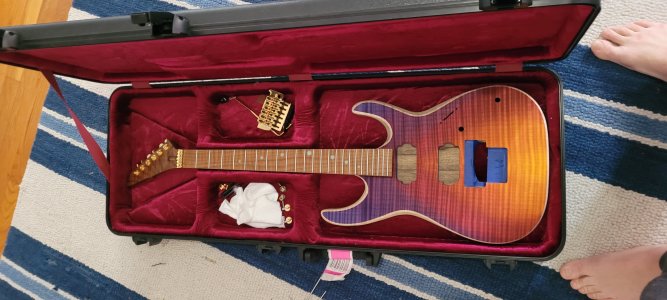phatstats
Junior Member
- Messages
- 29
Hey everybody, I put a lot of time into learning how to dye wood (my first attempt to finish wood ever!) And I think I got a pretty cool result. I have the guitar grain filled and dyed up, but now I'm wondering what a procedure looks like to get this thing a polyester or urethane resin clear gloss without disturbing the dye. Ive seen a million and one procedures for polyurethane, but I'd like to go the polyester or urethane resin route simply because this is going to be my beater/gigging guitar since my present gigging guitar has appreciated to the point where I don't really feel comfortable taking it out with me and as I understand it, polyester is near bulletproof as long as you don't drop it (Im unconcerned with the suspected slight drop in acoustic resonance that is reported but unproven since this is obviously a higher gain electric anyways). I have the following questions:
1) I am terrified of polyurethaning over shellac myself due to witness lines, but I am confident this procedure would not disturb the dye itself because I have shellac'd over dye with an LVLP gun successfully on scraps so far, and as I understand it, from there the dye would be locked in and no issues would persist btwn dye itself and the polyurethane. If applied with an LVLP gun, are witness lines really as prominent/easy to get as the internet makes it seem? Ive seen some seriously ugly looking errors out there... if it's something I'll be able to avoid if I try it 3 or 4 times on scraps? Great. 10 or 20 scraps? I've got time 40, 50+ times? Maybe not... how easy is polyurethane to work with and get a mirror out of?
40, 50+ times? Maybe not... how easy is polyurethane to work with and get a mirror out of?
2) are there procedures for polyestering yourself with some sort of intermediate layer that wont disturb dye? Ive contacted Solarez about their polyester resin over shellac as an intermediate, but they have no clue, and I'd rather at least have some information that what I'm attempting will work before grabbing a gallon of the stuff and testing on scraps.
1) I am terrified of polyurethaning over shellac myself due to witness lines, but I am confident this procedure would not disturb the dye itself because I have shellac'd over dye with an LVLP gun successfully on scraps so far, and as I understand it, from there the dye would be locked in and no issues would persist btwn dye itself and the polyurethane. If applied with an LVLP gun, are witness lines really as prominent/easy to get as the internet makes it seem? Ive seen some seriously ugly looking errors out there... if it's something I'll be able to avoid if I try it 3 or 4 times on scraps? Great. 10 or 20 scraps? I've got time
2) are there procedures for polyestering yourself with some sort of intermediate layer that wont disturb dye? Ive contacted Solarez about their polyester resin over shellac as an intermediate, but they have no clue, and I'd rather at least have some information that what I'm attempting will work before grabbing a gallon of the stuff and testing on scraps.



